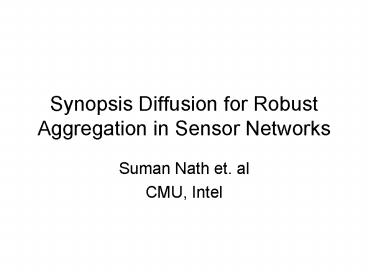Synopsis Diffusion for Robust Aggregation in Sensor Networks - PowerPoint PPT Presentation
1 / 20
Title:
Synopsis Diffusion for Robust Aggregation in Sensor Networks
Description:
Aggregates in-network saves energy. Popular approach is to create spanning tree ... Three Magic Functions to take care of all woes. Phases of SD. Distribution Phase ... – PowerPoint PPT presentation
Number of Views:171
Avg rating:3.0/5.0
Title: Synopsis Diffusion for Robust Aggregation in Sensor Networks
1
Synopsis Diffusion for Robust Aggregation in
Sensor Networks
- Suman Nath et. al
- CMU, Intel
2
Aggregation
- In large networks, aggregation queries more
important than individual sensor readings. - Aggregates in-network saves energy.
- Popular approach is to create spanning tree
- Drawback is that a single node failure can lead
to loss of the entire subbranchs data.
3
Stumbling Block
- Fundamental block is tight coupling of
aggregation and the required routing topology is
tightly couples. - This limits the advantage that can be achieved if
we were to use robust routing, like multi path
routing. - Multi path routing has a drawback i.e duplication
of data.
4
Synopsis Diffusion
- Synopsis Diffusion energy efficient multipath
routing smart algorithms to avoid double
counting - ODI Order and Duplicate Insensitive synopses
5
Papers Contributions
- A Novel Aggregation Framework
- Properties to characterize ODI Synopsis
- Better Aggregation Topologies
- Adaptive Ring Topology
- Example Aggregates
- Median
- Performance Evaluation
6
Synopsis Diffusion
- Synopsis Generation SG
- Takes sensor reading and generates a synopsis
- Synopsis Fusion SF
- Takes two synopses and generates a new one.
- Synopsis Evaluation SE
- Translates a synopsis into final answer.
- Three Magic Functions to take care of all woes
7
Phases of SD
- Distribution Phase
- Aggregate query is flooded through the network
- Aggregation Phase
- Each node uses SG to convert local data to local
synopsis and then uses SF to merge two synopsis
to create a new one. The query initiator uses the
SE to generate the final result.
8
Synopsis Diffusion
- Synopsis Label
9
ODI Correctness
- Algorithm is ODI correct if
- SF And SG Order and Duplicate
10
Properties
11
Semi Lattice
12
Error Bounds
13
Additional Examples
- Uniform sample of sensor readings.
14
Uniform Sampling (Cont)
15
Adapting the Topology
- Ring Topology
- Adaptive Ring Topology
- Nodes moves up or down in the rings dependent
upon the messages it overhears.
16
Evaluation
- 20 ft X 20 ft
- 600 sensors
- TAG Simulator
- Aggregation Scheme
- TAG ( standard tree based)
- TAG2 (value splitting between two parents)
- RINGS
- Adaptive RINGS
- FLOOD
17
Impact of sensor density
18
Sensor density on power consumption
19
Correlated Node failure
20
Conclusions
- First paper to use this approach.
- Acclaims four easy properties to solve
everything. - My thoughts are it is very hard to come up with
good SF and SG functions.































